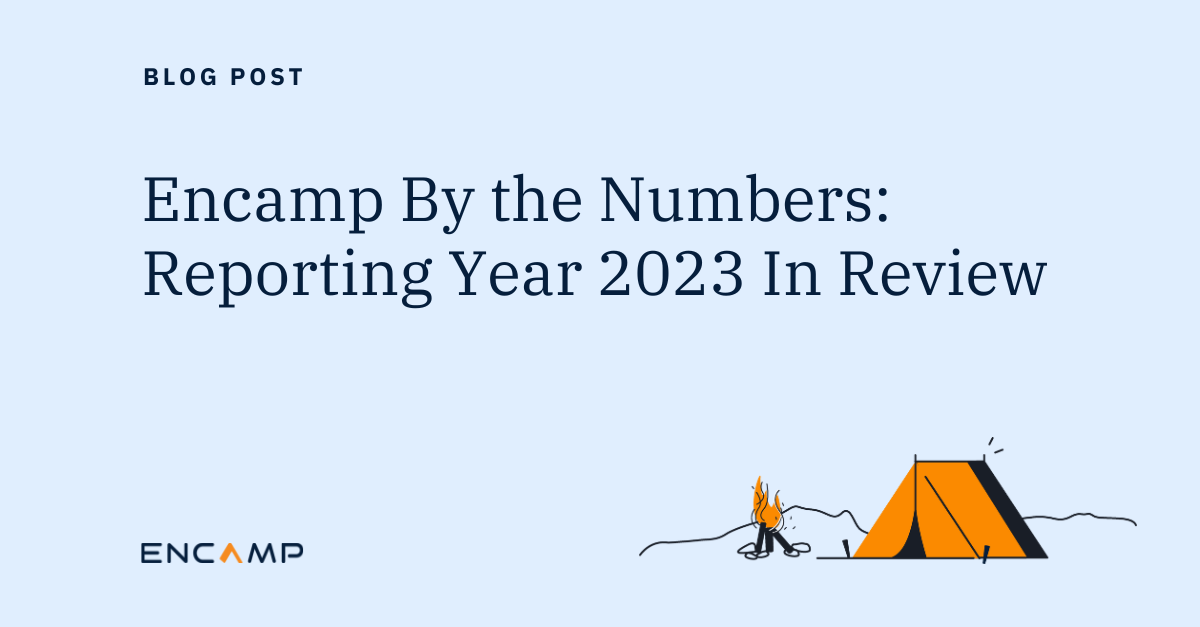Since 2018 Encamp’s Tier II Reporting solution has made us the EHS industry’s largest third-party filer of Tier II reports for Section 312 EPCRA compliance. As environmental regulation and compliance gurus who come from environmental management, state regulatory agency and EHS consulting backgrounds, we’ve helped our customers file thousands of Tier II reports to date… and counting.
So trust us, we know all about the complexities that come with Tier II reporting and environmental compliance regulations in general. We’re also fully aware of the problems of preparing Tier II reports and the errors that often show up during the report submission process.
Here are the Top 10 Tier II reporting issues we see most consistently — a checklist, if you will, to help your company avoid making the same mistakes:
Top 10 Errors
Checklist
- Companies don’t submit environmental compliance reports even though they should
- Chemicals are reported inconsistently across sites/facilities
- Chemical inventory is reported incorrectly or inaccurately
- Outdated or incorrect contact information
- Certain chemicals aren’t reported when they should be
- Chemicals are incorrectly-marked as extremely hazardous substances (EHSs)
- Increased reporting fees for incorrectly-marked chemicals
- Out-of-date Safety Data Sheets (SDSs)
- Wrong hazards are applied in reports
- Mixture components are incorrect
Guided Environmental Compliance
If even one of these issues applies to your company’s Tier II reporting, it’s a non-compliance red flag to regulators. Three or more? Maybe it’s time to re-examine your company’s reporting processes. Encamp’s Guided Environmental Compliance method blends high-tech solutions like digitization with high-touch support to make compliance data easier to manage for EPCRA compliance and automated Tier II reporting.
Along with our experienced Customer Success and compliance teams for all things Tier II, we aren’t just here to help you avoid reporting errors. We’re here to make sure your company maintains compliance via accurate EPCRA reporting and avoids non-compliance violations.
Common Tier II reporting errors in detail
#1: Companies don’t submit environmental compliance reports even though they should
It’s no secret that some companies don’t even realize EPA regulatory requirements like EPCRA Sections 311 and 312 apply to their facilities and certain hazardous chemicals. The Encamp technology’s built-in logic identifies chemical products and inventory levels that meet federal, state, and local reporting requirements for every facility and chemical, which ensures that you’re reporting when and where you should.
#2: Chemicals are reported inconsistently across sites/facilities
Companies report chemical names and related metadata inconsistently due mostly to human error and lack of attention to detail. For example, facilities contributing to Tier II report preparation many times don’t adequately identify and confirm extremely hazardous substances (EHS) on the EPA’s EHS list. Or they don’t properly verify the threshold planning quantity (TPQ) for an EHS. And whereas someone reports muriatic acid by its common name, someone else correctly reports the chemical hydrochloric acid. As a guardrail to ensure consistency, Encamp has integrated the EPA EHS list in its software, which lets you accurately populate hazardous chemicals by facility at implementation.
#3: Chemical inventory is reported incorrectly or inaccurately
Attribute this error to the same problems that lead to chemicals being reported inconsistently — but also add human error and the lack of a formal QA/QC process to ensure data quality and hygiene. Our technology automates reporting preparation and submissions to eliminate human error and provides built-in QA/QC checks for reporting tasks prior to report submission. Upfront during implementation, Encamp’s Customer Success and compliance teams also point out ways to merge products and contacts, eliminate unnecessary, outdated contacts, and explain state and local regulations if there’s confusion. Encamp’s compliance experts can also help with final reporting quality checks if customers request such assistance — essentially another step in guiding organizations through the compliance process.
#4: Outdated or incorrect contact information
Yes, keeping track of this information is usually mundane, manual work. But it’s surprising how often facility-level emergency contacts are overlooked, not updated, or not properly verified prior to report submission. Encamp lets you build and maintain contact profiles for every site, which puts the information at a user’s fingertips.
Helpful tip: To answer questions from a SERC, LEPC, or local fire department, a facility’s designated contact should be knowledgeable both about the chemicals onsite and the resulting Tier II report.
#5: Certain chemicals aren’t reported when they should be
Without a centralized solution to manage and track chemicals onsite, it’s easy for personnel handling Tier II reporting at the facility level to overlook short-term or seasonal chemicals. These can be chemicals used for cleaning, specialty products, R&D purposes and so on. EPCRA Section 312 specifies that a business must account for any chemical present at a facility. EPA describes “present” as being onsite at any given time during the year above the TPQ for an extremely hazardous substance. Therefore, while a chemical might be onsite for only a short period of time, if it exceeds a state or federal threshold while at the facility, it must be reported.
#6: Incorrectly-marked extremely hazardous substances
Many companies either designate EHSs incorrectly or fail to designate a chemical as an EHS in the first place. Encamp’s built-in logic automatically flags chemicals that are on EPA’s EHS list, even if those chemical substances are part of a mixture.
#7: Increased reporting fees for incorrectly-marked chemicals
In and of itself, paying/tracking/reconciling/allocating fees is a huge Tier II reporting burden, especially when operations expand to more states and your facility count increases. Imagine, however, that an amended report has to be filed because a chemical was marked incorrectly. Along with trying to find time for the rework, the fees to file an amended report are much steeper than for initial submissions.
#8: Out-of-date Safety Data Sheets
From EPA: In 2012, OSHA modified its Hazard Communication Standard (HCS) to conform to the United Nations’ Globally Harmonized System of Classification and Labeling of Chemicals (GHS). As part of these modifications, chemical manufacturers and importers are required to re-evaluate chemicals according to the criteria adopted from GHS in order to ensure that pure chemicals and mixtures are classified appropriately. Any new criteria must be provided to downstream users in safety data sheets (SDSs).
OSHA regulations require an SDS to be revised within three months after a chemical manufacturer or employer becomes aware of new information concerning the hazards of a chemical. EPCRA regulations merely require that such revised SDSs also be submitted to the agencies that have the original SDS. Facilities should therefore consult the OSHA regulations and guidance to determine if a revised SDS must be prepared and subsequently submitted under EPCRA.
#9: Wrong hazard codes in reports
Again from EPA: Pursuant to 29 CFR 1910.1200(b)(6)(i), the OSHA HCS that sets the requirements for Material Safety Data Sheets (MSDSs) does not apply to hazardous waste as defined by the Solid Waste Disposal Act, as amended by the Resource Conservation and Recovery Act (RCRA) of 1976. EPCRA sections 311 and 312 require reporting only on hazardous chemicals for which an owner or operator of a facility is required to prepare or have available an MSDS. OSHA does not require MSDSs for hazardous waste; therefore, hazardous waste is not subject to EPCRA sections 311 and 312. Since facilities are not required to maintain MSDSs for hazardous waste, they are not required to report for these chemicals if requested by an LEPC.
#10: Mixture components are wrong
A final word from EPA: If a facility that produces, uses, or stores mixtures knows or reasonably should know the components of the mixture, the facility owner or operator must notify under EPCRA Section 302 if the extremely hazardous substance component is more than 1% of the total weight of the mixture and equal to or more than the threshold planning quantity. Even if EHS component information is not available on the SDS provided by the manufacturer, facilities are not exempt from Section 302 notification requirements.
In addition, per EPA guidelines, the owner or operator of a facility may meet the requirements of Sections 311 and 312 by choosing one of two options:
- Providing the required information on each component that is a hazardous chemical within the mixture. In this case, the concentration of the hazardous chemical in weight percent must be multiplied by the mass (in pounds) of the mixture to determine the quantity of the hazardous chemical in the mixture. No MSDS must be submitted for hazardous components in a mixture with quantities in concentrations under 0.1% for carcinogens and 1% for all other hazardous components of the total weight of the mixture.
- Providing the required information on the mixture as a whole, using the total quantity of the mixture.
When the composition of a mixture is unknown, according to EPA, facilities should report on the mixture as a whole, using the total quantity of the mixture. Whichever option the owner or operator decides to use, the reporting of mixtures must be consistent for Sections 311 and 312, where practicable.
And that’s it. The Top 10 Tier II reporting errors we see day and day out. Use this checklist to make sure they don’t show up in your company’s reports.
Encamp is on a mission to create a world where good for business can equal good for the environment. We help enterprises transform compliance programs and human processes into a technology-driven system that lays the foundation for accurate and ongoing environmental compliance through a blended method of intelligent high-tech solutions and high-touch expert support.
Megan Walters
Megan is Encamp’s VP of Compliance & Customer Success and formerly a Senior Environmental Scientist. But she’s also a Certified Environmental and Safety Compliance Officer® (CESCO), an EHSMS Internal Auditor, a Certified Hazardous Materials Manager, eRailSafe certified, a HAZWOPER 40 Hour - Emergency Response Technician, and skilled in RCRA, DOT, and ISO 14001. Obviously, she knows “compliance.”



